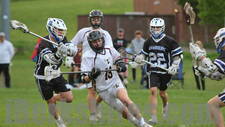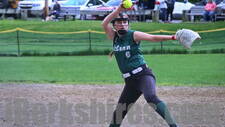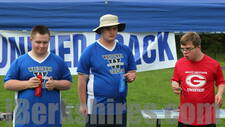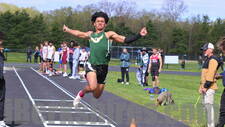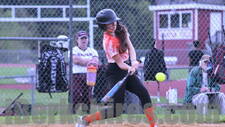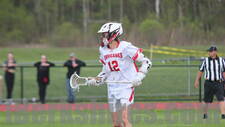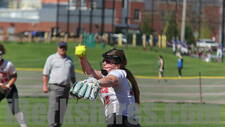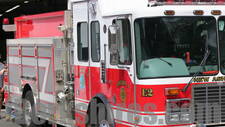iBerkshires.com Columnist SectionJoe Manning
More articles from Joe Manning
Bytes from the Bean by Joe Manning 02-0312:00AM / Monday, February 03, 2003
THEN AND NOW, PART II
Morning Conversations
Morning conversations in the cafe
circle ‘round the table
always coming back to
dates on cornerstones
old photos in newspapers
and the Flood of ‘27
Carl Robare, my friend and constant companion at the Bean, worked in the Strong-Hewat woolen mill for a few years after World War II, before serving 30 years as a technician with the phone company. He likes to tell the story about the co-worker who had lots of hair all over his body. He worked in the card room, where it was very hot, so the man was often shirtless. Carl explains, “With all the wool dust floating around, you could always tell what color wool they were manufacturing, because this guy would be the same color.â€
After I completed the “Then and Now†photo project for the North Adams Historical Society (see last month’s column), I started thinking about which changes had been an improvement, which had not, and how others would view it. My annual Oral History Project with Deborah Bullett’s seventh-grade classes at Conte Middle School is in full swing, so I brought in two sets of the photos.
First, I showed them the 1911 photo of the beautiful arched entrance to Apothecary Hall (85 Main), followed by the present view of the green wooden McClellands sign and glass doors. Then I showed them the 1968 photo of Bank Street (as viewed from Summer Street), followed by the present view from the (former) Kmart parking lot.
The reaction was a mixture of astonishment and laughter. After the comments and discussion died down, I decided to take a vote. So I held up each set and asked them to choose which scene they preferred. In both cases, the old photo won hands down, a reaction that surprised me, since these 12 and 13-year-olds haven’t had time to develop any sense of nostalgia.
Nostalgia is a seductive emotion. It lures us into believing that the old days were always better than the present ones. I sure hear a lot of that philosophy in morning conversations at the Bean. Certainly, not all the changes in our personal lives and in our community have been for the better. But as we get older, we sometimes forget that there were things in the “good old days†that were not so good.
Donald Surr grew up in North Adams and moved away in 1946. He and his wife live in Pennsylvania. I met them several years ago when I made a presentation to an Elderhostel group that was visiting the area. In a recent letter, Don told me:
“Although North Adams was a bustling and quite fascinating multi-ethnic community during its industrial heyday, it did have some serious environmental problems.â€
“The local woolen mills mixed powerful dyes in big vats that were emptied straight into the river after use. I can remember shuddering, as a boy very familiar and delighted with every other aspect of woolen cloth manufacture, every time I went through the dye house in Blackinton. The huge bubbling caldrons reminded me of witches' brew. Ghastly stuff! I always kept at a safe distance.â€
“They also used potent acid to carbonize, which means to burn out burrs in the wool. That also would have been dumped untreated into the river. I would imagine that the Arnold Print Works (current site of MASS MoCA) dumped in their share of potent chemicals, as well, since they specialized in applying colored patterns to cotton cloth which had been woven and bleached elsewhere.â€
“Other chemicals were used in applying special treatments to the printed cloth. It was not customary, in those days, to cart used industrial chemicals away for special treatment or disposal. That is one reason why factories located on the edge of rivers. Everything unwanted went straight in.â€
“With due respect to the memory of our industrial leaders, I do not believe that they were aware that they were endangering the environment. In those days there was a theory that rivers somehow cleansed themselves of impurities in the course of their flow, so nobody worried much about pollution. We just more or less took it for granted and assumed that nature would get rid of it somewhere downstream.â€
I find the Bank Street/Kmart parking lot photos hard to look at. Though I never visited North Adams until 1996, I am very sad that Bank Street was torn down. It was one of the things that gave the city its urban character. Former North Adams Transcript editor Lew Cuyler described it in an interview I did with him several years ago:
“Bank Street was like a canyon. The buildings were four stories high. It was a little street, the sidewalks were narrow, and the facades of the buildings were quaint. It was a special street. It wasn’t beautiful; no trees or nice Victorian street lights. It just was what it was. It was a place.â€
But in the urban renewal application filed by the North Adams Redevelopment Authority in 1964, the description of the area was far from flattering.
“Bank Street has an overall width of less than 30 ft. The other streets within the project area are almost equally inadequate. Congestion and poor access inhibit commercial development. These narrow streets also cause dangerous delay when the fire apparatus, housed on State Street, must reach an outbreak along Ashland or further south. The tenement buildings on Bank Street are blighted by reason of inadequate space and complete lack of community facilities such as open space and parking.â€
In my interview with Carl Robare three years ago, he seemed to agree with this assessment, and he offered some poignant and telling comments about how we view our history.
“In those days, when you came up Bank Street, you saw nice façades. But behind them, things were bad. There were apartment buildings that were built a 100 years ago, with roofs sagging, and other buildings around them that they had added something to. Somebody would use a building to store something; and then pretty soon, it was no good anymore. The shells of the buildings looked pretty good, but the insides of the shells were terrible. They were rat-infested three or four-story tenements with porches in the back. You couldn’t always see the rats, but you knew they were there.â€
“In the sixties, it was still the pre-mall days, so the storefronts were filled: Smith-Donovan Electric, Pizzi’s, Lurie’s, dress stores, Rosa Restaurant, Burlingame and Darbys, Roberts, and McCraw & Tatro. They were all nice, but they couldn’t survive today.â€
“A lot of people say, ‘Oh, things were wonderful back then.’ Well, we liked it. We’d come out of the phone company every day and walk over to Main Street, and it was full of people up and down. There was Newberry’s and Grant’s and Woolworth’s.†“It never couldn’t have lasted that way. We would be left with some nice-looking old buildings on the outside, but they would be empty.â€
“There was a little garage on Alton Place that my dad built with hand tools. It had a hip roof. I looked at it one day just before they tore it down, and I said to myself, ‘My father built that.’ It was sad, but it was from a different time, and it’s gone. Now the area is flat. It’s against the riverbank where the flood control is. I can still imagine all those little houses sloping down to the river with the rocks and dirt and crappy stuff in it. It was a different life then.â€
“I have a picture of a home my grandparents lived in over near the Braytonville Mill. It was a bunch of little hovels built on a slope going down to the mill. My grandparents had their first two or three children there. Can you imagine them looking back many years later and saying, ‘Gee, we used to live there. That was nice. We were just kids then, and we had a couple of children. We lived in a hovel in poverty and worked our heads off 80 hours a week in the mill. Wasn’t that wonderful?’ â€
“You can remember the past, but you can’t recreate it. And what one person remembers as being great, another remembers as being terrible. Did you ever go back years later to someplace you thought was really nice when you were a kid and ask yourself, ‘Why did I think that was nice?’ â€
“Some people look back and say, ‘Things are not the same.’ Of course they’re not the same. If you look at the old utility maps of North Adams in the late 1800s, you can see that the sewers came up the streets, and there were three or four places where they all just dumped into the river. Looking at the improvements in the river and the air and the other things in town, I would say that North Adams is a thousand percent better than it was then.â€
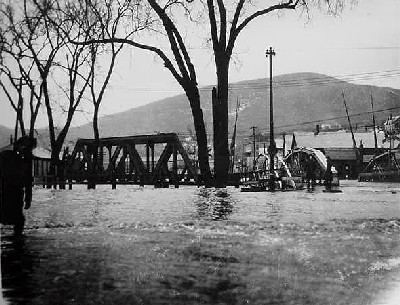
State Street railroad crossing, 1936, courtesy of Paul W. Marino

Photo by Joe Manning, 2002
Not being a native, I don’t know. I do know that since the 1950s, there haven’t been any serious floods. But I can’t help but wonder if many of those improvements have come at the expense of losing too much of our treasured past.
Other Peoples Memories
Wherever I walk in this city
I am followed by other people’s memories
making me nostalgic
for streets and buildings I never saw
friends I never knew
and the good old days I never lived through
The “Then and Now†exhibit at the North Adams Museum of History and
Science continues through June. Until April, it is open only on
Saturdays from 10:00 to 4:00, and Sundays from 1:00 to 4:00.
Visit Joe's website at: www.sevensteeples.com.
Email Joe at: manningfamily@rcn.com.
|
|
Advertise on
iBerkshires.com
|




